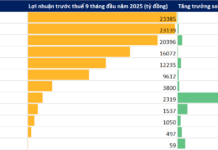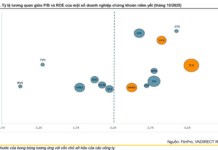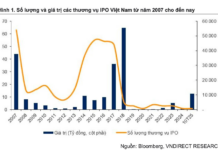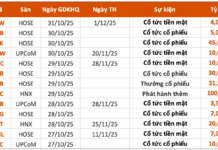
2023 has been regarded as one of the most challenging years for Vietnam’s economy in recent years due to multiple risks and volatilities stemming from the global landscape, such as decelerating global growth, elevated global inflation, tightening monetary policies in many countries, and intensifying geopolitical tensions.
Vietnam’s economic growth in 2023 remains significantly lower than the pre-COVID-19 period. Specifically, the gross domestic product (GDP) in 2023 expanded by 5.05% compared to 2022, only slightly higher than the growth rates of 2.87% and 2.56% recorded in 2020 and 2021, respectively, during the 2011-2023 period.
It is noteworthy that the most prominent factor has been the weakness in aggregate demand and its major components, namely consumption and investment, along with a lack of improvement in growth quality. In 2023, Vietnam’s aggregate demand components all exhibited a slowdown in growth. Specifically, final consumption expenditure and gross fixed capital formation increased by 3.52% and 4.09%, respectively (significantly lower than the 7.09% and 5.40% growth rates in 2022). Both indicators have yet to recover to pre-pandemic growth levels. Both final consumption and gross capital formation (investment) grew below the overall growth rate (5.05%).
Consequently, GDP growth in 2023 was largely driven by the difference in merchandise and service exports and imports based on comparable prices, with a narrower deficit than the previous year (exports declined by 2.54%, while imports fell by 4.33%).
In this context, the National Economics University in Hanoi recently partnered with the Central Economic Committee and the National Assembly’s Economic Committee to organize a National Scientific Conference to evaluate Vietnam’s economy in 2023 and its prospects for 2024. The conference also marked the launch of the university’s annual publication, Vietnam Economic Review 2023. The theme of both the conference and the annual publication this year is “Vietnam’s Economy in 2023 and Its Prospects for 2024: Stimulating Aggregate Demand for Economic Growth in a New Context.”
In his opening remarks at the conference, Professor Pham Hong Chuong, President of the National Economics University, emphasized that restoring aggregate demand is a crucial task for Vietnam in 2023. This requires the government and relevant ministries, agencies, and sectors to swiftly implement appropriate measures.
“Aggregate demand plays a critical role in determining the level of economic activity and employment in an economy. Declining aggregate demand exposes the economy to recession risks, adversely affecting the overall growth rate, and leading to consequences such as industrial production decline, rising unemployment, and reduced income and household spending,” Professor Chuong said.
In the Long Run, the Economy Cannot Rely on Public Investment
The impact of adverse factors and uncertainties in the global economic landscape has led to downward revisions in growth forecasts for Vietnam in 2024 compared to 2023. Growth projections by international organizations range from 5.5% to 6.0%, lower than the 6.0% to 6.5% plan set by the National Assembly.
Overall, in 2024, research experts anticipate that Vietnam’s economy will face numerous destabilizing, unpredictable, and negative impacts from the global economy. The impact of the global economic slowdown and volatility since the COVID-19 pandemic will likely continue to affect Vietnam’s economy, at least in the first half of 2024, before more positive signs emerge.
Domestically, traditional growth drivers from aggregate demand (investment, consumption, and exports) remain weak, the business sector continues to face numerous challenges, and new growth drivers are yet to emerge. Financial and macroeconomic environments, such as the monetary and financial system, the corporate bond market, the gold market, and the real estate market, still pose significant risks. Institutional reforms to facilitate new growth drivers have been slow in implementation, and public service delivery has been hampered by widespread inaction due to fear of making mistakes or taking responsibility. Meanwhile, growth quality remains low, and the growth model has not significantly improved.
“Therefore, in 2024, the Vietnamese economy is projected to face numerous difficulties and challenges. The likelihood of achieving the targeted growth rate is challenging,” the report stated.
Explaining this assessment at the conference, Professor To Trung Thanh, Head of the Science Management Department at the National Economics University, noted that given the lack of substantial improvement in the economic model, achieving high growth targets in 2024 (short-term) would require the government to rely primarily on demand-side policies.
“Growth drivers from aggregate demand (investment, consumption, exports) need to recover swiftly and be further strengthened. Private investment is unlikely to increase significantly due to challenges faced by the business sector, so increasing the disbursement and quality of public investment plays a crucial role,” Professor Thanh said.

Professor To Trung Thanh, Head of the Science Management Department at the National Economics University, speaks at the conference. Source: Organizing Committee
The government needs to stimulate private consumption by stabilizing the macroeconomic environment, adjusting income tax, increasing the stability of financial markets, and promoting social welfare policies. Diversifying export markets and leveraging the FDI sector to boost exports are also important solutions to focus on.
“However, in the long run, the economy cannot rely on public investment. Solutions are needed to improve the investment environment and unlock private investment as the primary and most important growth driver,” Professor Thanh said.
Based on their analysis and assessment of Vietnam’s current situation and the global economic landscape, the authors presented several macroeconomic policy recommendations to stimulate aggregate demand. Accordingly, on the fiscal side, the government could consider further implementing counter-cyclical fiscal policies to stimulate aggregate demand and achieve stable growth amidst a recession, especially when the budget deficit is not excessive, and public debt is trending downward. It is necessary to actively and proactively use fiscal policies to stimulate growth and address issues related to declining growth. Specifically, the government should accelerate the disbursement of public investment effectively and could consider further reducing certain taxes and fees to support businesses and stimulate demand.
On the monetary side, the report indicated that to facilitate the stimulation of credit growth and meet targets, the State Bank of Vietnam (SBV) should issue and revise several legal documents related to credit access. Simultaneously, the SBV should implement policies to increase the level of credit access, especially for small and medium enterprises (SMEs), as well as reduce lending interest rates.
For example, it is necessary to strengthen dialogue and networking between banks and businesses to enhance information sharing, disseminate knowledge, understand needs, and promptly address difficulties and obstacles. Specific regulations should be issued requiring commercial banks to publicly disclose critical information related to credit provision, including average lending interest rates, various fees, fee calculation methods, and average annualized real interest rates.





































